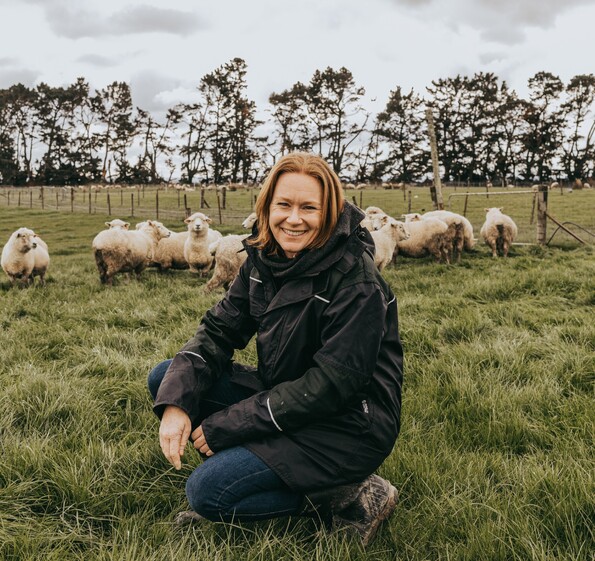With a bit of media around drench resistance lately, we had a chat with Ginny Dodunski, Wormwise Programme Manager at Beef + Lamb New Zealand, about what drench resistance means for farmers and how they can effectively manage worms on their farms.
Ginny is a self-proclaimed ‘sheep geek’ and has spent more than twenty years as a vet in New Zealand and Australia. More recently, she has moved to Beef + Lamb New Zealand to focus on worms and improving the sustainability of internal parasite management on Kiwi farms.
“I started my veterinary career with Trevor Cook in Fielding – that was back in the late nineties – and Trevor was talking then about the fact that if farm systems don't change that things were going to tip over with drench failure,” says Ginny.
She likens it to worrying about your own health or climate change: until you’ve actually had a heart attack or there’s a tornado over the house, it’s easy to just put things off and worry about them later.
Ginny recalled when she worked in Australia for a year in the early 2000s, where drench resistance was becoming widespread and 20 percent of a mob of lambs could be dead with resistant barber’s pole worm (Haemonchus). That was when she keenly felt that if New Zealand didn’t act, then the same thing would happen here eventually.
“It’s just human nature that it’s taken people to have a crisis for us to take interest in it.”
While worms can kill animals in different ways – blood loss, dehydration, diarrhoea, etc., deaths and sick young animals are the tip of the iceberg, and growth performance is being lost well before we can see anything with our eyes. Well-fed animals are better able to tolerate worm challenge: “what you put down their throat every day matters more than what you put down their throat once a month”, says Ginny.
Regular and effective drenching is a key part of managing and eliminating worms on New Zealand farms.
Most of the drenches on the market are combinations of different chemicals; the theory being that it’s less likely for a worm to have genes for resistance for two or more drugs – at least one drug should work and kill the worm.
Unfortunately, Ginny says, this combination theory has been relied on too heavily as the main means to delay resistance - by the time combinations were in wide use there was already substantial underlying resistance to the individual actives, and unchanged patterns of drench use have simply bred up combination-resistant worms. Data from Awanui Veterinary Laboratories indicates that triple-combination resistance in the black scour worm (Trichostrongylus) has risen from 3 percent of tests in 2017 to 33 percent of tests in 2021.
So, since drench resistance poses a serious threat to our animals and our farm businesses, it is important to continue to drench correctly, as well as instigate other practices that can reduce the prevalence and impact of worms.
Grazing rotation
Ginny asserts there is no magical length of time long enough for larvae levels to drop in pasture without stock – that is practical for farmers anyway.
After six to nine months, there should be a substantial drop-off in worm larvae on pasture, but farmers can’t typically rest their pastures for that long. Something that farmers can do is lengthen grazing rotation as much as possible for calves and lambs, as they are big contributors of eggs and larvae onto pasture and can quickly re-infect themselves when grazing contaminated areas. Adult animals, and those of an alternate species, can follow behind lambs and calves in a ‘clean-up’ role.
“If a paddock has had lots of sequential grazings with lambs that have been under regular drench treatment without any monitoring, there's your potential resistance hotspot that you then want to clean up with cattle and ewes and be quite careful that lambs don't go back there,” explains Ginny.
“The longer time that you can leave between grazing a paddock now with lambs and then coming back again with the lambs and the more cleanups you can do in between, the better.”
She knows how hard it is feeding young stock, with less paddocks having a suitable contour and good feed quality and that’s why they end up rotating the same areas quite frequently.
“The majority of the worm larvae that are going to be challenging the animals are in the bottom third of the pasture, so the more that we can keep our young stock grazing just in the tops and cleaning up behind them with other stock, that's also good from a worm point of view,” says Ginny.
Cultivation
Doing cultivation of a paddock can really help to break the cycle of worms. 10 to 15 percent of a total worm population can exist in the first centimetre of soil, so any action that exposes these to the elements – like ploughing the soil, turning it over and burying the worms – makes it harder for them to continue their life cycle.
Single season crops such as summer brassicas can be more effective at reducing worm challenge, as they need to be replanted often and thus the soil gets regularly turned or exposed. Conversely, with multi-season crops such as plantain or lucerne, you need to be more careful to monitor worm build-up and be careful of how you use drenches to avoid creating a ‘resistance hot spot’.
Water and stock camps
In extensive grazing situations, high levels of worm larvae can be found in areas where animals congregate, such as water points and stock camps: “you’ve got the double whammy of all the animal faecal pats going in that same area and they’re grazing down really low,” explains Ginny.
These spots can have high rates of contamination – what can you do to keep vulnerable stock moving and not mooching around in these areas?
Type of drug
There are three types of applications when it comes to drench: topical (pour-on), oral and injected.
“Drench going down the throat generally has a higher kill rate,” explains Ginny, “because not only do you get the direct contact of the drug with the worm in the gut, but a lot of the drug is also absorbed through the rumen wall and then circulates back in the blood and is secreted back into the gut.”
Although topical drenches can be a lot easier and safer for farmers – especially when dealing with large animals – she asserts that the other methods are far more effective.
There is one exception to the preference of oral drenches, says Ginny, and that is Ostertagia in adult cattle because that worm can burrow into the lining of the fourth stomach and an injection gets more drug to where the worms are.
Dosage
An important part of avoiding drench resistance is giving the right dose to the animals. Smart technologies where drench guns are hooked up to weigh scales can ensure that the animals get the exact dose they need and can also save money as drench isn’t used unnecessarily.
If you aren’t going to weigh each animal as they are drenched, it is important to drench to the heaviest weight of the mob, not the average weight.
“People often underestimate the weight of their stock, so I think there is a lot of under drenching going on for sure,” Ginny says.
Farmers have been playing around with the timing of ending drenching in calves and lambs, for example, really well grown calves from around nine months of age can be getting pretty immune to a lot of the worms, and the best-performing individuals may not need further treatments after this time, as long as they’re well-fed.
Faecal egg counting of ewe hoggets from April onwards often highlights that these animals need far less drench over the winter than what might have been standard.
Do the checks
To confirm if a drench has worked, Ginny recommends as a starting point, taking faecal samples 7 – 14 days after application (7 – 10 days for oral drenches and 14 days for injections and pour-ons). If they show that egg counts are zero or close to it, then the drench has worked well. If not, “that’s the start of a conversation with your animal health advisor – who shouldn’t be the guy that sells you drench”, Ginny says.
If you continue to drench without checking the efficacy, then you could unknowingly be trying to kill worms again and again with a drench they are resistant to.
What the future looks like
Climate change will inevitably affect worm challenge, says Ginny, making it more of an issue for farmers as time goes on.
“Barber’s pole worm…that used to only be a North Island thing, we're seeing it as far south as Southland now and we saw an outbreak of it in central Otago a couple of years ago.
“The facial eczema monitoring project that Beef + Lamb are doing at the moment where they're sampling sheep poo from all over the country looking for facial eczema spores, those have been found in Canterbury and Otago. So, all of those supposed North Island diseases, they are definitely moving south.”
Normally, the cold weather further down south breaks the life cycle of most worms and other bugs, but as global warming continues and New Zealand temperatures keep rising, more and more farmland will be ripe for these parasites to occupy and multiply.
Keep it simple
Ginny believes that the foundation of New Zealand productive agriculture basically starts with good grazing management: “I still think the farmers that we see that do really well, are profitable, are the best ones at converting pasture by grazing into animal product.”
“I was just on a sheep dairy farm yesterday where I'd been called in as sort of the parasite expert, but the parasites weren't the issue at all,” shares Ginny.
“We spent the whole time talking about rotations and covers and residuals and the condition of the ewes. When you get all those things right, the worms go away (in that system).”
Ginny has spent the last 12 months building the new Wormwise website, an excellent resource for farmers and consultants that includes guidance about worms found in New Zealand, managing for lower worm challenge, drenches and monitoring, and lots of other useful information.
Head to https://beeflambnz.com/wormwise to find out more.

